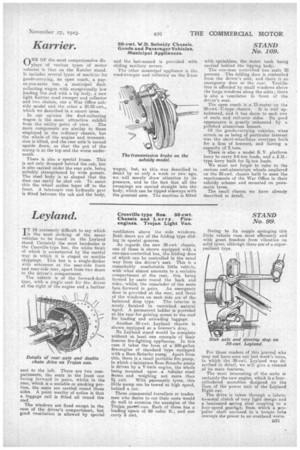Karrier.
Page 25

If you've noticed an error in this article please click here to report it so we can fix it.
30-cwt. W.D. Subsidy Chassis. Goods and Passenger Vehicles. Municipal Appliances.
STAND No. 109.
ONE OF the most comprehensive displays of various types of motor vehicles is that on the Ka,rrier stand. It includes several types of machine for goods-carrying, an open coach, a payas-you-enter bus, a municipal dust. collectingwagon with exceptionally low loading line and with a tip body, a new light Karrier road sweeper and collector and two cha'ssis, one a War Office subsidy model and the other a 20-25-cwt., which we described in a recent issue.
In our opinion the dust-collecting wagon is the most attractive exhibit from the utility point of view. The main components are similar to those i employed n the ordinary chassis, boa the whole of the engine and transmission is tilted, and the rear axle is turned upside down, so that the pot of the casing is at the top and the worm underneath.
There is also a. special frame. This is not only dropped behind the cab, but is also carried under the rear axle, being suitably strengthened by wide gussets. The steel body is so shaped that the dust can easily be shot out. To assist this the wheel arches taper off to the front. A telescopic ram hydraulic gear is fitted between the cab and the body,
and the last-named is provided with sliding sanitary covers.
The other municipal appliance is the road-sweeper and collector on the 2-ton wagon, but, as this was described in detail by us only a week or two ago, we will merely draw attention to its presence, and to the fact that all the sweepings are carried straight into the body, which can be tipped sideways with the greatest ease. The machine is fitted with 6prinklers, the water tank being carried behind the tipping body.
The one-man controlled bus seats 20 persons. The folding door is controlled from the driver's seat, and there is an emergency door at the rear. Ventilation is afforded by small windows above the large windows along the sides; there is also a ventilator in front of the driver's seat.
The open coach is a 15-seater on the
30-cwt. C-type'ehassis. It is well upholstered, and it has doors to each row of seats and roll-over sides. Its good appearance is greatly enhanced by a polished aluminium bonnet.
Of the goods-carrying vehicles, what struck us as being of particular interest was the short-wheelbase overtype built for a firm of brewers, and having a capacity of 2-tons. There is also a model K.V. platform lorry to carry 5-6-ton loads, and a JR.type lorry built for 3i-ton loads.
We must not forget to refer to the curious cast-aluminium wheels employed on the 30-cwt.. chassis built to meet the requirements of the War Office in their subsidy scheme and mounted on pneumatic tyres. The small chassis we have already described in detail.








































































